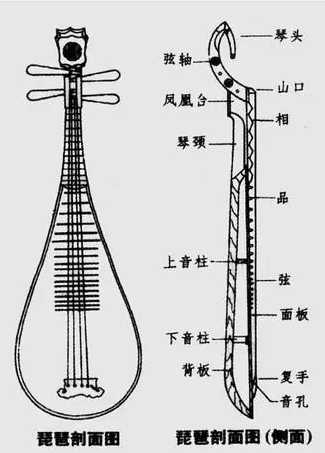The structure of the lute
The head of the pipa is composed of "string groove", four "zhenzi (string shaft)", "mountain pass" and so on.
The upper end of the body of the pipa is also called the "neck", that is, the place of "phase". The overlapping part of the upper end of the neck is called "pillow". The middle and lower parts are "grade". is a phonetic device. The middle and lower parts of the body are narrow at the top and wide at the bottom, the bottom is semi-circular and hollow, that is, the sound box; , There is a small hole on the panel at the center of the cover hand, which is called "sound hole" or "sound hole". The back of the body is called "Pipa back", the upper end of the back is connected to the head, the middle and lower part of the back is bonded to the panel, and there are two other rungs and several sound columns in the abdomen, which are placed at certain positions; The materials made of red sandalwood, black materials, old mahogany, rosewood, fragrant mahogany, etc. are top grades, and those made of white wood are popular ones, because red sandalwood, mahogany and other woods are good at producing natural overtones during playing.

The pipa is composed of six phases and twenty-four frets, which form the twelve equal temperaments with a wide range. The first string is steel wire, and the second, third and fourth strings are steel rope nylon winding strings. The sound of the pipa is very special. Its overtone ranks first among all kinds of musical instruments in ancient and modern China and abroad. It not only has a loud volume, but also has a crisp and bright sound quality. At the same time, the fundamental tone of the pipa is accompanied by rich overtones, which can make the sound of the lute attenuate less during transmission and have strong penetrating power. When playing in a calm open space, use it to play heavy tones. The sound of the piano can be transmitted two or three miles away.
High-quality pipa sound has strong penetrating power (small attenuation and long distance transmission). The treble is bright and rigid, the midrange is soft and smooth, and the bass is solid. In Bai Juyi's poem "Pipa Xing", "the big string is noisy like a torrential rain, the small string is like a whisper, noisy and choppy, and the big and small beads fall on the jade plate." , the iron cavalry highlights the sound of swords and guns. At the end of the song, be careful with the strokes, the sound of the four strings is like cracking silk.” Now it is no longer an artistic exaggeration of the poet, but a veritable performance of the contemporary pipa.
The "head", "body" and "Zhenzi" of the pipa are mostly made of hardwood, colored wood, pear wood, rosewood, wenge, rosewood, ebony, and rosewood. Among them, the high-grade pipa axes are also made of horns, bones, and ivory.
The panel is made of Henan Lankao paulownia, and most of the handrails are made of perennial bamboo.
 渝公网安备 50010702504639号
渝公网安备 50010702504639号